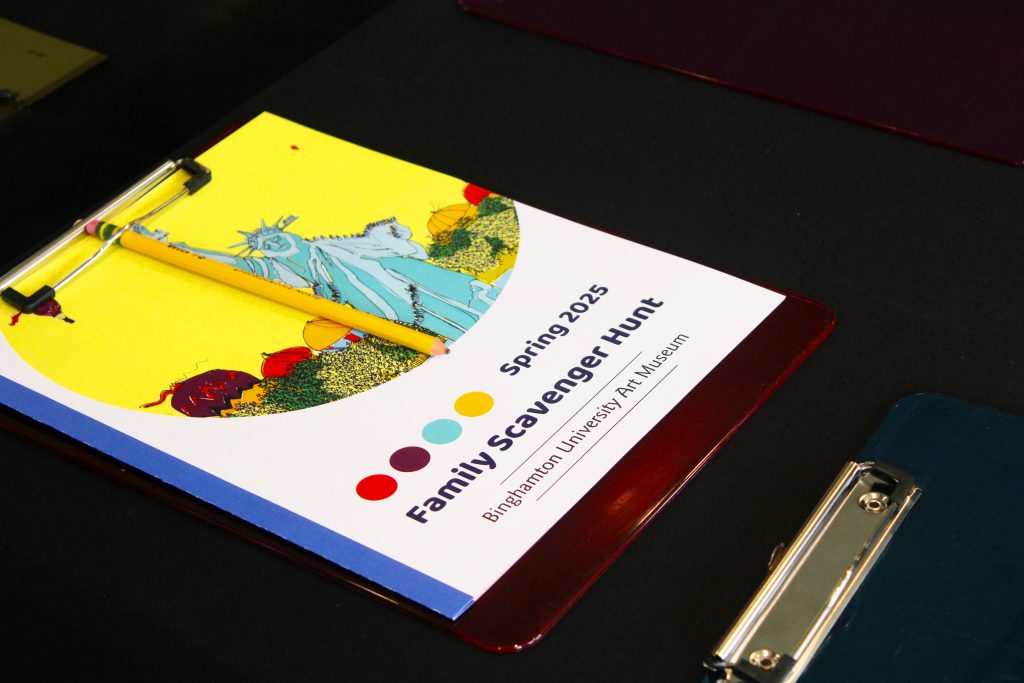The University Art Museum hosted Family Day, a free and public event, last Saturday. The event connected the campus and surrounding community with art showcases in the spring 2025 exhibition, “Monuments: Commemoration and Controversy.”
Curated by Wendy Nālani E. Ikemoto, the vice president and chief curator at The New York Historical, the exhibit explores public monuments and the key roles they play in politics and identity. Some of the pieces featured include fragments of a destroyed King George III statue and a smaller model of New York City’s first public monument to a Black woman, which honored Harriet Tubman.
The Family Day event invited families, students and community members to immerse themselves in the exhibition through a scavenger hunt and clay monument construction to experience sculpture and monument building. The scavenger hunt was catered to kids, with coloring pages that encouraged them to note how the monuments made them feel. They wrote down what each of their senses picked up throughout the exhibit.
Amanda Jean Lynn, the coordinator of education and public programs at the Art Museum, said she created this event to get children involved with art and foster a strong connection to the arts.
“So many kids don’t have a ton of chances to be exposed to art and we try to encourage them to visit and explore our galleries to start having conversations about art and what art means to them,” Lynn wrote in an email. “I think that with the tremendous upheaval we are seeing within the arts and culture sectors at this particular point in our history, it is absolutely critical to get younger folks engaged and excited about the arts and start having these tough conversations.”
After finishing the scavenger hunt, community members tapped into their creative side by replicating some famous monuments from the exhibit, like the Statue of Liberty. Others molded and sculpted their favorite flowers. The creation process facilitated a discussion about why each person chose to create each monument.
The exhibit featured statues and paintings of monuments, many of which were torn down. The museum highlighted how some of the art featured predominantly white men, completely disregarding the people of color and women who helped facilitate the movements depicted and honored in these works. Among the paintings of the statues being erected and destroyed were blurbs that brought attention to the unseen figures behind these projects.
Alongside the physical monuments present were illustrated recreations of famous statues, like the Statue of Liberty and Harriet Tubman’s monument, along with information about their impact. Each piece and statue compiled a story of creation, destruction, silencing and commemoration as viewers are taught to recognize the struggles not pictured in each piece.
Paige Velez, an Art Museum docent and a senior majoring in anthropology, emphasized the importance of early-level education in the arts and how the current exhibit plants seeds for complex conversations.
“It’s important for elementary school students to learn about the people that are often left out of the main historical narrative,” Velez said. “It’s important to look at the narratives of people that are not often talked about and the narratives of the most marginalized.”
Families who gathered for this event were greeted with a scavenger hunt clipboard, encouraging the kids to look for specific pieces and reflect. After exploring the museum, the kids could get hands-on experience in monument-making.
After walking around the gallery, clay monument-making was a perfect way to interact with the art and reflect on why the artists created their pieces. This event neatly connected the difficult conversations brought up by the creation and destruction of monuments while creating an immersive experience for all ages.
“We can learn a lot about monuments based off of who is not represented in the monuments,” Velez said. “A lot of times, the most marginalized people are not represented in these monuments, or their contributions to the lifespan of the monument is not often talked about. And I also think it’s important to look at not only just what the monument is representing, but like the process of monument-making and the process of monument-breaking if our norms change and we no longer want a certain ideal memorialized.”



